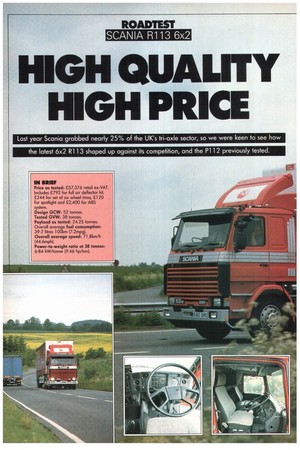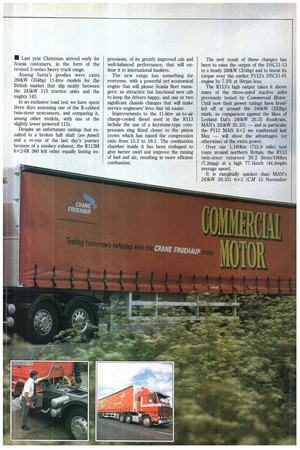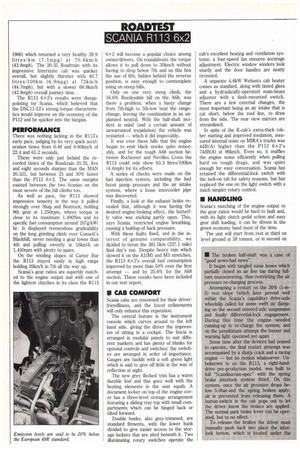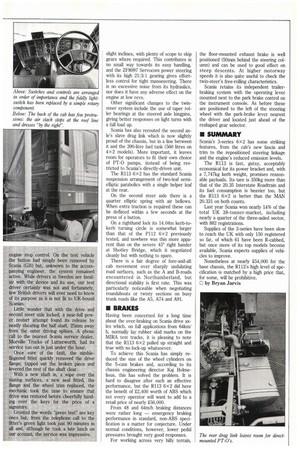HIGH QUALITY HIGH PRICE
Page 58

Page 59

Page 60

Page 61

If you've noticed an error in this article please click here to report it so we can fix it.
Last year Scania grabbed nearly 25% of the UK's tri-axle sector, so we were keen to see how the latest 6x2 R113 shaped up against its competition, and the P112 previously tested.
I/ Last year Christmas arrived early for Scania customers, in the form of the revised 3-series heavy truck range.
Among Santa's goodies were extra 260kW (354hp) 11-litre models for the British market that slip neatly between the 245kW 113 tractive units and the mighty 143.
In an exclusive road test we have spent three days assessing one of the R-cabbed twin-steer newcomers, and comparing it, among other models, with one of the slightly lower powered 112s.
Despite an unfortunate mishap that resulted in a broken half shaft (see panel) and a re-run of the last day's journey because of a smokey exhaust, the R113M 6x 2/4R 360 left other equally lasting im pressions, of its greatly improved cab and well-balanced performance, that will endear it to international hauliers.
The new range has something for everyone, with a powerful yet economical engine that will please Scania fleet managers; an attractive but functional new cab to keep the drivers happy, and one or two significant chassis changes that will make service engineers' lives that bit easier.
Improvements to the 11-litre air-to-air charge-cooled diesel used in the R113 include the use of a keystone-type compression ring fitted closer to the piston crown which has raised the compression ratio from 15.2 to 16:1. The combustion chamber inside it has been reshaped to give better swirl and improve the mixing of fuel and air, resulting in more efficient combustion. The nett result of these changes has been to raise the output of the DSC11-13 to a heady 260kW (354hp) and to boost its torque over the earlier P112's DSC11-01 engine by 7.5% at 50rpm less.
The R113's high output takes it above many of the three-axled tractive units previously tested by Commercial Motor. Until now their power ratings have levelled off at around the 240kW (332hp) mark, so comparison against the likes of Leyland Dots 240kW 20.35 Roadtrain, MAN's 243kW 20.331 — and in particular the P112 MAN 6x2 we roadtested last May — will show the advantages (or otherwise) of the extra power.
Over our 1,180km (733.9 mile) test route around northern Britain, the R113 twin-steer returned 39.2 litres/100km (7.2mpg) at a high 77.1km/h (44.6mph) average speed.
It is marginally quicker than MAN's 243kW 20.331 6x2 (CM 15 November 1986) which returned a very healthy 39.9 litres/km (7.1mpg) at 70. 6km/h (43.8mph). The 20.35 Roadtrain with its impressive Interstate cab was quicker overall, but slightly thirstier with 40.7 litres/100km (6.9mpg) at 72km/h (44.7mph), but with a slower 68.8km/h (42.8mph) overall journey time.
The R113 6x2's results were dissappointing for Scania, which believed that the DSC11-13's strong torque characteristics would improve on the economy of the P112 and be quicker into the bargain.
PERFORMANCE
There was nothing lacking in the R113's early pace, judging by-its very quick acceleration times from 0-48 and 0-80km/h of 22.4 and 61.2 seconds.
These were only just behind the recorded times of the Roadtrain 20.35, five and eight seconds sharper than the MAN 20.331, but between 25 and 30% faster than the P112 6x2. The same margins existed between the two Scanias on the most severe of the hill climbs too.
As well as pace, the R113 showed impressive tenacity in the way it pulled strongly over Shap and Beattock, holding 9th gear at 1,250rpm, where torque is close to its maximum 1,490Nm and its specific fuel consumption around 207g/kW/ hr. It displayed tremendous gradeability on the long grinding climb over Consett's Blackhill, never needing a gear lower than 4th and pulling sweetly at 161ari/h on 1,450rpm with plenty to spare.
On the winding slopes of Carter Bar the R113 stayed easily in high range holding 261cm/h in 7th all the way up.
Scania's gear ratios are superbly matched to the engine output and with one of the lightest clutches in its class the R113 6x 2 will become a popular choice among owner/drivers. On roundabouts the torque allows it to pull down to 301ardh without having to drop below 7th and on this box the use of 6th, hidden behind the reverse position, is easy enough to comtemplate using on steep Mils.
Only on one very steep climb, the 16.6% Reedesdale hill on the A68, was there a problem, when a hasty change from 7th-high to 5th-low beat the rangechange, leaving the combination in an unplanned neutral. With the half-shaft incident in mind (and a certain amount of unwarranted trepidation) the vehicle was restarted — which it did impeccably.
It was over these hills that the engine began to emit black smoke quite noticeably, and for the tough A68 section between Rochester and Nevilles Cross the R113 could only show 63.3 litres/100km (4.4mph) for its efforts.
A series of checks were made on the fuel injection system, including the fuel boost pump pressure and the air intake system, where a loose intercooler pipe was discovered.
Finally, a look at the exhaust brake revealed that, although it was having the desired engine-braking effect, the butterfly valve was sticking partly open. This, says Scalia, restricted engine breathing, causing a buildup of back pressure.
With these faults fixed, and in the interest of genuine comparability, we dicided to rerun the 381.51an (237.1 mile) final day's run. Despite heavy rain which slowed it on the Al(M) and M1 stretches, the R113 6x2's overall fuel consumption improved by more than 10% over the first attempt — and by 25.6% for the A68 section. These results have been included in our test report.
II CAB COMFORT
Scania cabs are renowned for their driverfriendliness, and the latest refinements will only enhance this reputation.
The central feature is the instrument console which curves around to the left hand side, giving the driver the impression of sitting in a cockpit. The fascia is arranged in modular panels to suit different markets and has plenty of blanks for optional controls and switches; the switches are arranged in order of importance. Gauges are backlit with a soft green light which is said to give off little in the way of reflection at night.
The new grey flecked trim has a warm durable feel and this goes well with the heating elements in the seat squab. A document locker on top of the engine cover has a three-level storage arrangement featuring a sliding tray top with small compartments which can be hinged back or tilted forward.
Double bunks, also grey-trimmed, are standard fitments, with the lower bunk divided to give easier access to the storage lockers that are sited beneath it. Two illuminating rotary switches operate the cab's excellent heating and ventilation systems: a four-speed fan ensures accurage adjustment. Electric window winders look sturdy and the door handles are neatly recessed.
A separate 4.6kW Webasto cab heater comes as standard, along with tinted glass and a hydraulically-operated main-beam adjuster with a dash-mounted switch. There are a few external changes, the most important being an air intake that is cut short, below the roof line, to draw from the side. The rear view mirrors are streamlined.
In spite of the R-cab's extra-thick rubber matting and improved insulation, measured internal noise on MIRA's tracks was 4dB(A) higher than the P112 6x2's 74dB(A) at 96Icm/h. Even so, it muffles the engine noise efficiently when pulling hard on tough drags, and was quiet enough for easy conversation. Scania has retained the differential-lock switch with the lock-on tab for safety reasons, but has replaced the one on the light switch with a much simpler rotary control.
• HANDLING
Scania's matching of the engine output to the gear ratios would be hard to fault and, with its light dutch pedal action and easy gear shift loading, it can be driven in the green economy band most of the time.
The unit will start from rest in third on level ground at 38 tonnes, or in second on slight inclines, with plenty of scope to skip gears where required. This contributes in no small way towards its easy handling, and the ZF8097 Servocom power steering with its high 21:3:1 gearing gives effortless control for tight manoeuvring. There is no excessive noise from its hydraulics, nor does it have any adverse effect on the engine at low revs.
Other significant changes to the twinsteer system include the use of taper roller bearings at the steered axle kingpins, giving better responses on light turns with a full load up.
Scania has also rerouted the second axle's slave drag link which is now slightly proud of the chassis, but in a line between it and the 390-litre fuel tank (560 litres on 4x2 models). More important, it leaves room for operators to fit their own choice of PT-0 pumps, instead of being restricted to Scania's directly-driven unit.
The R1I3 6x2 has the standard Scania suspension arrangement of two-leaf semielliptic parabolics with a single helper leaf at the rear.
On the second steer axle there is a quarter elliptic spring with air bellows. When extra traction is required these can be deflated within a few seconds at the press of a button.
On a righthand lock its 14.04m kerb-tokerb turning circle is somewhat larger than that of the P112 6 x2 previously tested, and nowhere was this more apparent than on the severe 450 right hander at Shotley Bridge, which it negotiated cleanly but with nothing to spare.
There is a fair degree of fore-and-aft cab movement over sharply undulating road surfaces, such as the A and B-roads encountered in Northumberland, but directional stability is first rate. This was particularly noticeable when negotiating roundabouts or twisty sections on busy trunk roads like the A5, A74 and A91.
• BRAKES
Having been concerned for a long time about the over-braking on Scania drive axles which, on full applications from 64krn/ h, normally lay rubber skid marks on the MIRA test tracks, it is pleasing to note that the R113 6x2 pulled up straight and true with no lock-up whatsoever.
To achieve this Scania has simply reduced the size of the wheel cylinders on the S-cam brakes and, according to its chassis engineering director Kaj Holmelious, this has solved the problem. It is hard to disagree after such an effective performance, but the R113 6x2 did have the benefit of 22,400 worth of ABS which not every operator will want to add to a retail price of nearly £56,000.
From 48 and 64m/h braking distances were rather long — emergency braking performance in standard, non-ABS specification is a matter for conjecture. Under normal conditions, however, lower pedal pressures brought very good responses.
For working across very hilly terrain, the floor-mounted exhaust brake is well positioned (50mm behind the steering column) and can be used to good effect on steep descents. At higher motorway speeds it is also quite useful to check the twin-steer's free-rolling characteristics.
Scania retains its independent trailerbraking system with the operating lever mounted next to the park brake control on the instrument console. As before these are positioned to the left of the steering wheel with the park-brake lever nearest the driver and located just ahead of the reshaped gear selector.
• SUMMARY
Scania's 3-series 6x2 has some striking features, from the cab's new fascia and trim to the repositioned steering linkage and the engine's reduced emission levels.
The R113 is fast, gutsy, acceptably economical for its power bracket and, with a 7,747kg kerb weight, promises reasonable payloads. Its tare is 350kg more than that of the 20.35 Interstate Roadtrain and its fuel consumption is heavier too, but the R113 6X2 is better than the MAN 20.331 on both counts.
Last year Scania won nearly 14% of the total UK 38-tonner-market, including nearly a quarter of the three-aided sector, with 882 registrations.
Supplies of the 3-series have been slow to reach the UK with only 150 registered so far, of which 61 have been R-cabbed, but once more of its top models become available, Scania expects supplies of vehicles to improve.
Nonetheless at nearly £54,000 for the base chassis, the R113's high level of specification is matched by a high price that, for some, will be prohibitive.
0 by Bryan Jarvis
























































































































































